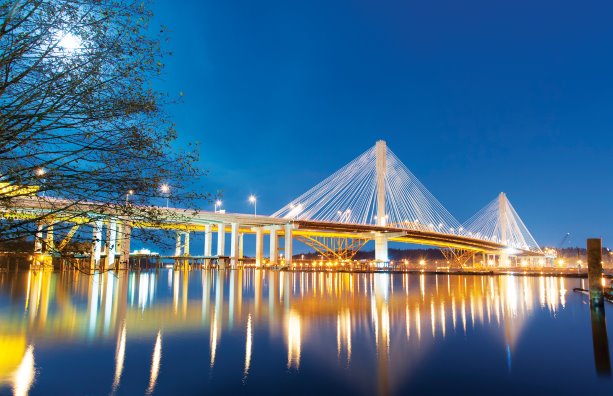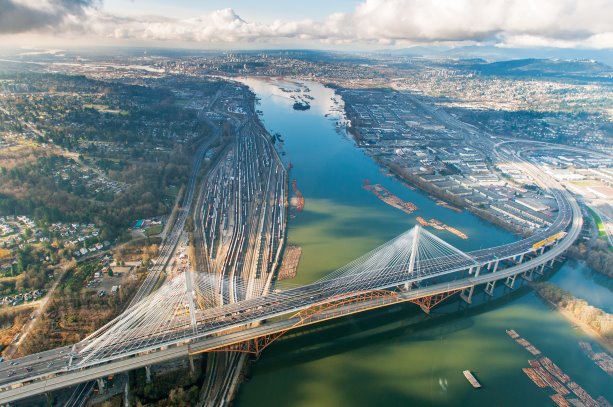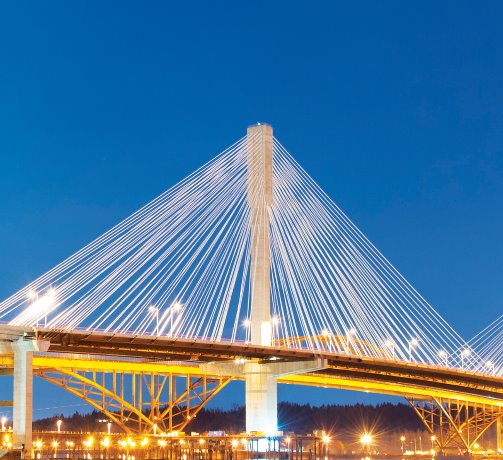The Port Mann Bridge project, the largest transportation infrastructure project in B.C. history, wrapped up this month, on time and on budget. Port Mann/Highway 1 construction concluded with the launch of the mega project’s live travel time information displays to show how long a Port Mann driver’s commute will be.
"Without the builders and visionaries behind the Port Mann/Highway 1 Project, drivers would still be bumper-to-bumper in Western Canada’s worst bottleneck," said Todd Stone, Minister of Transportation and Infrastructure during a visit to the bridge.
"Today, commuters and commercial drivers are saving valuable time – more than three hours a week compared to the Pattullo Bridge."
The project included building the second-longest cable stay bridge in North America, which was recognized as the widest bridge in the world by the Guinness Book of World Records. It is the largest and longest main span river crossing in Western Canada.
The project also included 37 km of highway improvements from Langley to Vancouver, as well as the construction of nine highway interchanges. After originally being conceived as a public-private partnership, Kiewit/Flatiron General Partnership were awarded the $2.4 billion contract to design and build the project.
The consortium includes Peter Kiewit Sons Co. and Flatiron Constructors Canada Limited. The final construction costs for this project are pegged at $3.3 billion dollars, which includes financing, operating, maintenance and rehabilitation costs. The displays marked the end of more than six years of construction of the largest transportation infrastructure project in B.C.’s history.
Minister Stone concluded the project by thanking drivers for their patience and workers for completing the project on time and on budget.
The Port Mann Bridge is one of the busiest crossings in Canada with about 100,000 crossings a day. Travel time surveys confirm drivers are saving as much as 40 minutes a day by taking the Port Mann Bridge compared to the Pattullo Bridge. Year-to-date traffic on the bridge is five per cent higher than in 2014 and continues to increase as more drivers choose Port Mann and the improved Highway 1.
"This was a very challenging project because of keeping traffic moving on the highway. We’ve got one of the busiest economic corridors on Highway 1 going through Metro Vancouver and to operate a megaproject highway rehabilitation while keeping traffic moving is a tremendous challenge," said Greg Johnson, communications manager for Transportation Investment Corporation (TI Corp), the Crown corporation tasked with overseeing the project. The number of detours that were planned and put in place were far longer than the corridor itself.
"The biggest lessons taken from this really comes from the traffic management part of it and how you can keep the traffic flowing during the day and do the vast majority of the work overnight," he said. Traffic diversion wasn’t the only challenge of the project.
In addition to building the new bridge, crews had to carefully dismantle the 50-year-old original Port Mann Bridge right beside the site of the new one using blueprints from the 1960s. This involved essentially deconstructing it in the reverse order it was built. Demolitions teams conducted underwater blasting while maintaining the safety of the Fraser River’s fish population. Crews also had to tackle the problem of ice accumulation on the cables. Custom designed robots were deployed to clear ice build up from the cables. TI Corp. must now turn its attention to paying for the $3.3 billion in improvements. Johnson said they are on track to meet the 2050 payment deadline.
"In the first couple years of operation we saw drivers taking the opportunity to try the alternate routes," Johnson said. "What we’ve seen in the past seven months, drivers are continuing to come back to the Port Mann to save time rather than fight traffic."
Project Facts and Figures
- 3.1 million m3 of earthworks
- 28,000 tonnes of rebar and 13,000 tonnes of structural steel
- The new 10 lane bridge is the second-longest cable stay bridge in North America
- $3.3 billion capital budget
- 288 cables measuring a total of 45 kilometres
- 2 bridge towers, each 158 metres high
- 1,158 pre-cast concrete segments make up bridge approaches
- 25,000 tonnes of asphalt used for the bridge deck
- 8,000 person years of employment
- First bus service over the Port Mann in 25 years
- First ever pedestrian and cyclist crossing at the Port Mann

1/2
Construction of the $3.3 billion Port Mann/Highway 1 Project has official wrapped up. Peter Kiewit Sons Co. and Flatiron Constructors Canada Limited were awarded the contract.
Photo: TI Corp
2/2
28











Recent Comments
comments for this post are closed